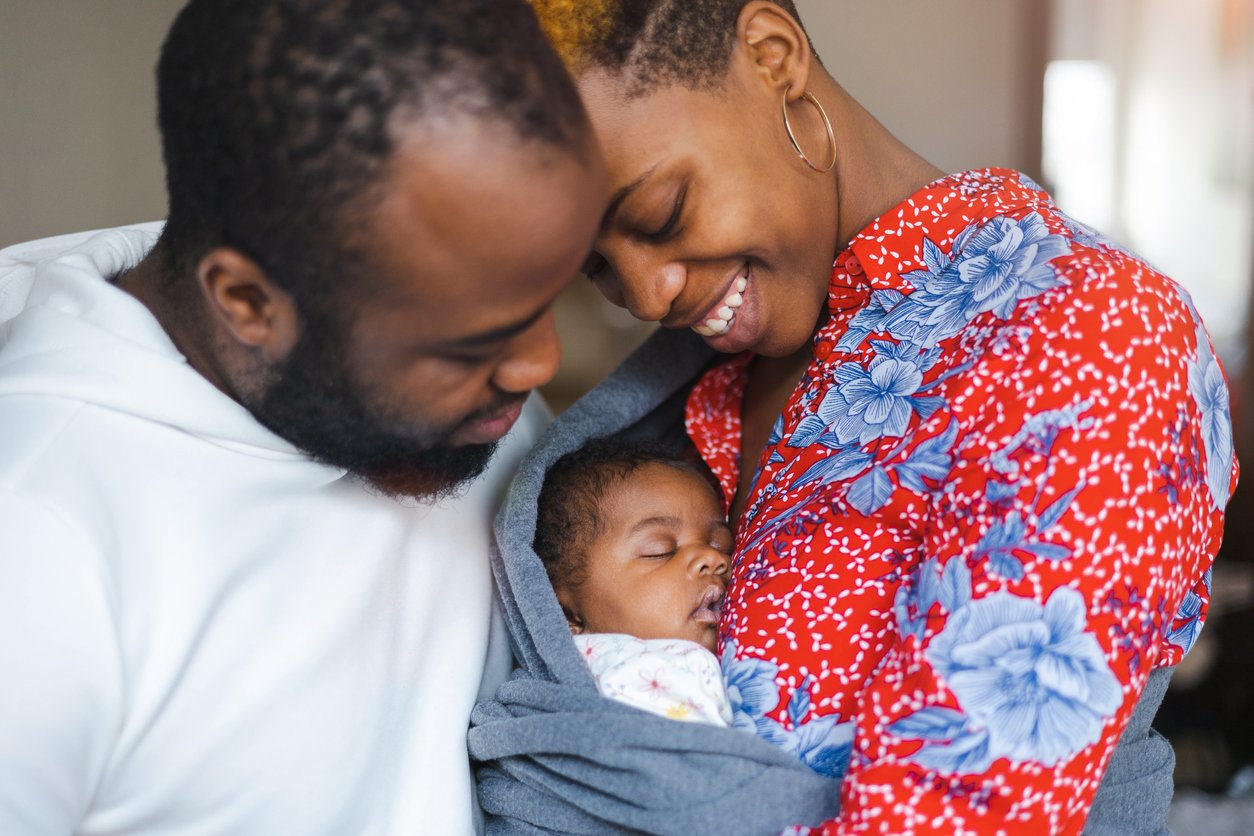Communication Habits of Successful Couples
Takeaway: Your relationship after having a baby will often experience periods of adjustment as you adapt to your new roles and responsibilities. The ability to communicate openly and effectively is crucial for couples in asking for help when needed, finding ways to reconnect with each other, and seeking support from others. Here are some communication habits of successful couples.
Young parents with their baby girl at home.
Whether you've been together for decades, or are just starting out, healthy communication habits are key to maintaining a successful relationship. Few things are more disheartening than feeling like you and your partner are speaking different languages. The ability to communicate openly and effectively is crucial. This is especially true when a couple is going through a big life transition - like welcoming a child, which can bring with it postpartum mental health issues and huge changes in lifestyle.
One of the most successful and well-known approaches to communication in relationships comes from Dr. John Gottman, a marriage expert and professor emeritus of psychology at the University of Washington, who developed the Sound Relationship House Theory to explain what makes up successful couples. In his theory, Gottman identified seven components that lay the foundation for successful communication in relationships.
The 7 Levels of the Sound Relationship House Theory
Gottman laid out his theory as a visual representation of a house. Each floor represents a different element necessary for a successful relationship. The walls are built upon trust and commitment. As he explains, "Building a sound house requires skilled labor by both partners."
The seven levels of the Sound Relationship House Theory are:
Build Love Maps: Get to know your partner on a deeper level and understand their hopes, dreams, values, and fears.
Share Fondness and Admiration: Make sure you express appreciation for the other person's positive qualities.
Turn Towards Each Other: Spend quality time together and make sure you are available to respond when your partner needs you.
The Positive Perspective: Always look for the positive in any situation, even if it is difficult. Try to empathize with each other's feelings, and create a safe place where both partners feel heard and understood.
Manage Conflict: When conflict arises, take a step back and approach it in a calm and respectful manner. Listen to each other's perspectives before coming to an agreement.
Make Life Dreams Come True: Share your dreams for the future with your partner. Then, you both can work towards making them come true.
Create Shared Meaning: Engage in meaningful conversations and activities that bring you closer together, such as exploring your spiritual beliefs or engaging in philanthropic activities.
As you build your marriage after the baby, keep the 7 Levels of the Sound Relationship House Theory in mind, held together with trust and commitment. Then, continually look for opportunities to apply these principals to your everyday life for healthier communication habits.
Practicing Non-Violent Communication for Healthy & Productive Communication Habits in a Relationship
While Gottman's framework provides a great foundation for successful relationships, it's also important to have practical tools and tips that can be applied in everyday communication. One such tool is practicing non-violent communication (NVC). NVC is a process of learning to communicate our needs and feelings in a way that doesn't involve threats, guilt trips, or finger-pointing. This communication style creates an environment where both partners feel safe to express themselves honestly without fear of judgment or criticism.
A man comforting his wife at home while she is looking upset. ·
Non-violent communication identifies four components of NVC:
Observation: Start by expressing what you see and hear without adding your interpretations or judgments.
Feelings: Express how you feel in a clear and direct way.
Needs: Identify the needs that are behind your feelings and express them in a non-demanding way.
Request: Ask for what you want in a clear and direct manner, without making demands or using guilt trips.
Rosenberg's approach gives a practical step-by-step guide for expressing your emotional needs to your partner. His hypothesis is that due to the structure of the English language, we often find ourselves casting blame and making judgments without even realizing it.
If we recognize this breakdown in communication, we understand that nearly every conflict is born of an unmet need. Thus, it can be solved by properly expressing those needs. This segues into the final point: recognizing harmful communication habits.
Avoiding Toxic Communication Habits
Shot of a young couple looking frustrated and arguing at home.
Lastly, now that you've got a handle on the positive aspects of communication in relationships, it's important to examine the other side of the coin: negative communication habits. This part is especially important for new parents in a heightened state of stress and exhaustion.
The "Four Horsemen of the Apocalypse" theory identifies four destructive patterns of communication that can be damaging to a relationship:
Criticism: Instead of pointing out your partner's flaws, focus on how you feel and why you feel that way.
Contempt: Avoid attacking your partner in a way that makes them feel devalued or inferior.
Defensiveness: Instead of playing the blame game, be open to feedback and look for ways to meet halfway.
Stonewalling: Don't shut down emotionally when faced with a conflict. Acknowledge your partner's feelings and take time to process the situation.
Toxic communication habits can often be the most damaging aspect of a relationship. If any of these communication patterns become habitual, it may be best to seek outside help from a therapist or marriage counselor.
You're Not Alone in This Journey
There are a variety of communication strategies and practical tools available to help couples navigate their unique relationship. With this knowledge in hand, couples can make informed decisions on how to best communicate with each other. But, knowledge only takes us so far. Applying knowledge to our everyday lives is the tricky part.
Whether you're newly married or have been together for years, it's important to find a balance between honoring the past and looking forward to the future. Your relationship after the baby will often experience periods of adjustment as you adapt to your new roles and responsibilities. Asking for help when needed, finding ways to reconnect with each other, and seeking out support from others can all be helpful strategies in re-establishing a strong bond between partners.
Happy parents playing with their baby son on the bed.
If you're seeking assistance with building your communication skills and creating a strong foundation for your relationship, consider reaching out to a professional today. A trained therapist can provide you with the guidance and support needed to navigate through this stage of your relationship.





